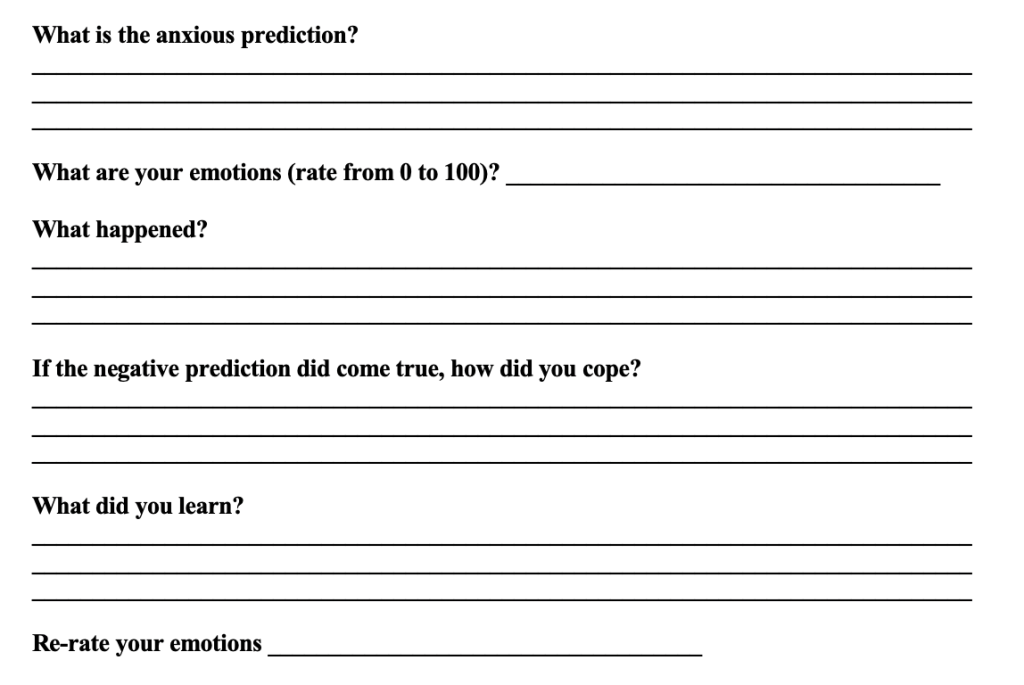How negative predictions impact our mental well-being
Oftentimes, people can be trapped in vicious cycles that maintain their problems because hidden underlying negative beliefs or predictions. Take for example a man who has been struggling with depression for 7 years. Whenever he considers doing something that could be enjoyable (e.g., taking a walk, trying out a new hobby), he immediately thinks to himself: “I’m not going to enjoy that” and decides to banish his thoughts of trying.
Although it was unconscious and automatic, this man has made a prediction, believed it to be true, and decided to withdraw from engaging in potentially enjoyable activities. Perhaps unbeknownst to him, following this prediction is maintaining a vicious cycle contributing to his depression.
Behavioural experiments as a CBT tool to test negative predictions
Behavioural experiments are a great CBT tool that people can use in their everyday life to tackle their psychological worries and other challenges. Therapists also commonly employ behavioural experiments in their practice as part of cognitive behavioural therapy!
Behavioural experiments test negative predictions that increase distress, maintains psychological challenges, and limit our world. I’ll list out some negative predictions that people with different mental health challenges may experience:
Depression: “I won’t be able to take a walk. I’m too tired”, “there’s no point trying this activity. I won’t enjoy it”
Social anxiety: “they’ll think I’m boring”, “other people don’t want to talk to me”
Panic disorder: “I can’t go outside. I won’t be able to handle it. I might get a heart attack”
Generalized anxiety disorder: “if I don’t set several alarms and worry constantly, I’ll definitely miss my appointment and it’ll be very troublesome”
Insomnia: “if I get out of bed, I won’t ever be able to fall back asleep”, “I won’t be able to function at all tomorrow if I don’t sleep now”
As you can see, many common disorders have underlying fearful predictions, which we do our best to avoid. However, because of this avoidance we never know whether the belief is actually true or if it’s not. Avoidance maintains our problems. This is why behavioural experiments can be such a powerful tool. It provides real-world evidence of whether our belief is true or not.
How to create a behavioural experiment
A behavioural experiment is when we take on the role of a curious experimenter and test whether these beliefs are true or not. Therefore, we are not married to an outcome (though we have a hypothesis – which is our prediction); we simply observe to see what happens.
1. Jot down the situation. Example: calling an acquaintance to hang out.
2. Write down your anxious prediction. Example: “if I call them to hang out, they’re going to reject me and be annoyed at me”
3. Write down your emotions and their intensity (0-100). Example: anxious (90%), worried (80%), shame (60%)
3. Conduct the experiment! Example:Make the call to your acquaintance!
4. Write down what happened. Example: They were happy I called. They weren’t available this week, but we made plans next Monday at lunch to grab food at a restaurant nearby our workplace.
5. Write down what you learned. I learned that my belief wasn’t actually true. My new friend didn’t mind me calling at all and now I have something to look forward to next week!
6. Re-rate your emotions.
And that’s it! Creating a behavioural experiment is not nearly as tough or rigorous as a scientific study. It does, however, take a little courage to try out the experiment. If an experiment is too tough at first, I would encourage you to try out an easier experiment first and move your way up.

What if the experiment fails and my anxious prediction was true all along?
Well, let’s say in the case above the acquaintance ends up saying no. What happens next? Well, you might feel a little awkward, ruminate a bit, and feel somewhat uncomfortable the next time you see this person. But you survived!
And that’s the important thing. When we engage in behavioural experiments, we do not just test whether a prediction is true or not. We also test our ability to cope when our negative prediction does happen to be true in certain cases. By knowing that the worst-case scenario can happen (e.g., not being able to sleep the whole night in insomnia, missing an appointment in generalized anxiety disorder), but we survived and got through the day, we learn that we are more resilient than we think!
If you found this post helpful, please consider subscribing to the mailing list for more evidence-based information on mental health!
Best wishes,
P

